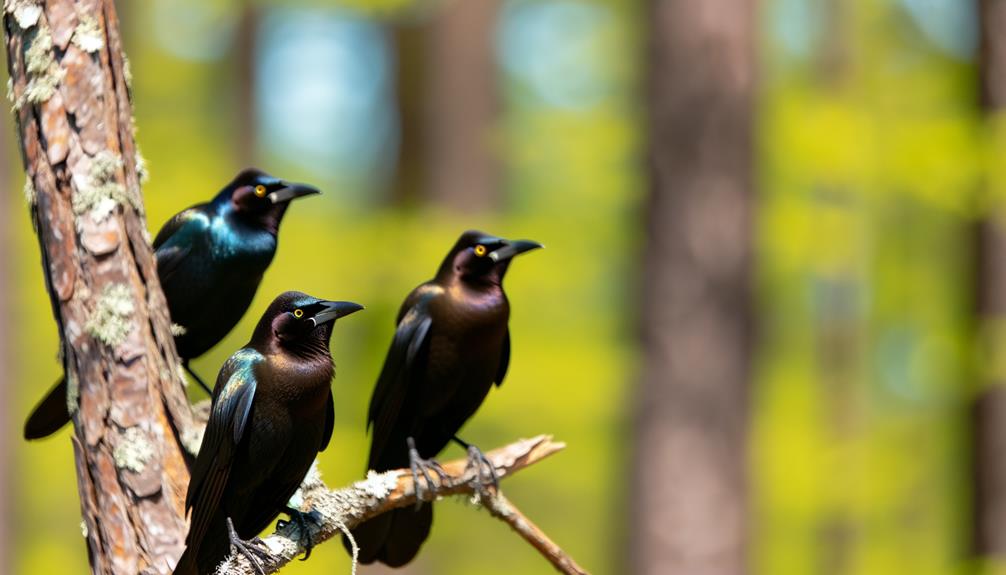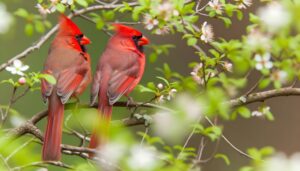Common Grackle Bronzed Cowbird Northern Cardinal: A Guide
The Common Grackle, Bronzed Cowbird, and Northern Cardinal illustrate a fascinating spectrum of avian diversity and ecological roles. The iridescent Common Grackle thrives from the Rockies to the Atlantic, exhibiting communal roosting and opportunistic feeding.
The Bronzed Cowbird, known for brood parasitism, affects host species’ reproductive success, ranging from the southern U.S. to Central America.
Meanwhile, the Northern Cardinal, with its striking red plumage and complex songs, adapts well to varied habitats from southern Canada to Central America. Each species’ unique behaviors and habitats offer deeper insights into avian ecology and interspecies interactions, promising intriguing discoveries.

Key Takeaways
- Common Grackles are large, iridescent blackbirds known for their territorial aggression and complex social structures.
- Bronzed Cowbirds exhibit brood parasitism, laying eggs in other birds’ nests to outcompete host offspring.
- Northern Cardinals are known for their vibrant red plumage, especially in males, and their complex vocalizations for mate attraction and territorial defense.
- Common Grackles thrive in diverse environments, including urban areas, wetlands, and woodlands, and show seasonal movement patterns.
- The Bronzed Cowbird’s parasitic behavior influences avian community structures and highlights interspecies relationships in bird ecology.
Common Grackle vs Bronzed Cowbird vs Northern Cardinal: Key Differences
| Feature | Common Grackle | Bronzed Cowbird | Northern Cardinal |
|---|---|---|---|
| Appearance | Iridescent black with a purplish or greenish sheen, long tail, and sharp beak. | Glossy black (males) with red eyes; females are brownish-black. | Bright red (males) or brown with red accents (females); distinctive crest. |
| Size | 11-13 inches (28-33 cm) | 7.5-8.5 inches (19-21 cm) | 8-9 inches (20-23 cm) |
| Range | Throughout North America, in open and suburban areas. | Southern U.S. and Central America, in open fields and pastures. | Widespread in eastern and central U.S., common in backyards. |
| Diet | Omnivorous; eats insects, seeds, grains, and even small animals. | Mostly seeds and insects; lays eggs in nests of other birds. | Primarily seeds, fruits, and insects; visits bird feeders often. |
| Behavior | Social, often in large noisy flocks, can be aggressive. | Known for brood parasitism, laying eggs in host bird nests. | Solitary or in pairs, known for their melodious song and territorial nature. |
| Breeding | Nests in colonies in trees or shrubs. | Does not build nests, lays eggs in the nests of other birds. | Builds cup-shaped nests in shrubs or trees; both parents help raise chicks. |
| Call | Harsh, metallic calls; a variety of sounds. | High-pitched, whistling calls, less musical. | Sweet, melodious whistles, one of the most beautiful bird songs. |
Common Grackle Overview

The Common Grackle, Quiscalus quiscula, is a large, iridescent blackbird that inhabits a variety of environments across North America, displaying remarkable adaptability and aggressive foraging behaviors.
This species thrives in diverse habitats, including wetlands, farmlands, urban areas, and woodlands. Its iridescent plumage exhibits a spectrum of colors, from metallic blue to bronze, depending on light conditions.
Grackles exhibit sexual dimorphism, with males being larger and more vividly colored than females. Their diet is omnivorous, comprising insects, seeds, fruits, and small vertebrates, highlighting their opportunistic feeding strategy.
Nesting in colonies, grackles build cup-shaped nests using grass and twigs. Their vocalizations are a mix of harsh, squeaky calls, serving both communication and territorial functions.
Grackle Behavior Patterns
Observing grackle behavior reveals their complex social structures and territorial aggression, especially during breeding seasons when males display heightened defense of nesting sites. Males often engage in vigorous displays, including puffing their feathers and emitting loud, varied vocalizations to ward off intruders.
Females exhibit selective mate choice, preferring males with superior displays. Grackles are also known for their communal roosting, where hundreds gather in trees, forming large, noisy flocks. They exhibit coordinated foraging strategies, often in open fields, where they hunt insects and small vertebrates.
Their adaptability to different environments and opportunistic feeding habits highlight their ecological versatility. Intraspecific interactions, such as dominance hierarchies, play an important role in maintaining social order within flocks.
Grackle Habitat and Range

Grackles inhabit a diverse range of environments, from urban areas and agricultural fields to wetlands and woodlands, showcasing their remarkable adaptability.
Their range spans across North America, particularly from the Rocky Mountains to the Atlantic coast. They thrive in both rural and suburban settings, exploiting the resources available in each habitat.
Preferring open spaces, grackles often nest in tall trees and forage on the ground, displaying opportunistic feeding behaviors. Their presence is notable in riparian zones where water sources support abundant insect populations.
During winter, grackles migrate southwards to warmer regions, demonstrating seasonal movement patterns. Their adaptability to various ecological niches underlines their resilience and successful colonization across a broad geographical range.
Bronzed Cowbird Overview
The Bronzed Cowbird is easily identified by its iridescent bronze plumage and striking red eyes. It inhabits a vast territory ranging from the southern United States to Central America. This species favors open and semi-open environments such as agricultural lands, grasslands, and suburban areas.
The Bronzed Cowbird is known for its brood parasitism behavior, where it lays its eggs in the nests of other bird species, relying on them to raise its offspring. Despite this behavior, the cowbird primarily feeds on seeds and insects.
Physical Characteristics Overview
Though often mistaken for other blackbird species, the Bronzed Cowbird displays distinct physical characteristics, such as its iridescent bronze feathers and striking red eyes, which set it apart in its ecological niche.
The male Bronzed Cowbird, Molothrus aeneus, is particularly notable for its glossy plumage that shifts hues in sunlight, ranging from deep bronze to metallic green. Females, while less vibrant, exhibit a more subdued brownish-bronze coloration.
Both sexes have robust, conical bills suited for their varied diet. Their eyes, a vivid red, are a distinguishing feature that aids in species identification.
Additionally, their relatively short tails and stout bodies provide aerodynamic efficiency, enhancing their mobility within diverse habitats. These attributes collectively distinguish the Bronzed Cowbird from its avian counterparts.
Habitat and Distribution
Inhabiting a wide range of environments, the Bronzed Cowbird thrives in both open grasslands and agricultural areas, where its adaptability to diverse habitats is evident. This bird ranges from the southern United States through Central America, revealing a preference for warmer climates. Its distribution is influenced by the availability of host species for its parasitic breeding behavior. The Bronzed Cowbird often occupies regions with abundant livestock, which stir up insects, a primary food source.
| Region | Habitat Type | Key Features |
|---|---|---|
| Southern U.S. | Grasslands | Open areas, scattered trees |
| Mexico | Agricultural lands | Croplands, cattle pastures |
| Central America | Mixed environments | Diverse plant life, open fields |
| Coastal Areas | Marshlands | Wetlands, dense vegetation |
| Urban Fringes | Suburban regions | Gardens, parks, urban edges |
This habitat diversity underscores its ecological versatility.
Behavior and Diet
Adaptability in diverse habitats is mirrored in the Bronzed Cowbird‘s behavior and diet, showcasing its opportunistic feeding strategies and social dynamics. This species primarily feeds on seeds and insects, often exploiting agricultural fields and grasslands. Its foraging behavior includes ground pecking and following livestock to disturb insects.
Bronzed Cowbirds exhibit brood parasitism, laying eggs in the nests of other birds, especially sparrows and blackbirds. This parasitic strategy reduces parental investment, increasing reproductive success. Socially, they form loose flocks during non-breeding seasons, enhancing foraging efficiency and predator detection.
Their adaptability underscores an evolutionary advantage, allowing them to thrive in varied environments from open woodlands to urban areas, indicating a high degree of ecological plasticity.
Cowbird Brood Parasitism

Cowbird brood parasitism is characterized by the female cowbird laying her eggs in the nests of other bird species. This disrupts the host’s reproductive success and creates complex ecological interactions. The parasitic cowbird egg often hatches earlier, and the chick grows faster, outcompeting the host’s offspring for food and parental care.
This parasitism leads to a decline in the host species’ reproductive output, impacting their population dynamics. Different bird species exhibit varying degrees of resistance; some recognize and eject the foreign egg, while others inadvertently nurture the cowbird chick.
These interactions influence avian community structures and can drive evolutionary adaptations. Understanding these processes offers insights into avian behavioral ecology and the broader implications of interspecies relationships.
Cowbird Habitat and Range
Understanding the ecological impacts of cowbird brood parasitism requires examining their habitat preferences and geographical range, which extend from the open grasslands of North America to the borders of tropical forests. Cowbirds demonstrate impressive adaptability to diverse environments, enabling them to thrive across various landscapes.
They prefer:
- Grasslands: Open areas offer plentiful foraging opportunities.
- Agricultural Fields: Proximity to human activity often enhances food availability.
- Forest Edges: Transitional zones between dense woods and open land support nest parasitism.
These habitats facilitate their parasitic breeding strategy by ensuring access to host nests. Their range stretches from southern Canada to Central America, highlighting their ecological flexibility.
Understanding this adaptability is essential for managing their impact on native bird populations and ecosystems.
Northern Cardinal Overview

The Northern Cardinal inhabits a diverse range of environments, from woodlands to suburban gardens, throughout eastern and central North America.
Its striking red plumage in males and subtle tawny hues in females provide a vivid example of sexual dimorphism.
This species thrives in areas with dense shrubbery, offering both ample foraging opportunities and ideal nesting sites.
Habitat and Range
Nestled in woodlands and gardens across North America, the Northern Cardinal thrives in a diverse array of habitats, ranging from dense thickets to suburban backyards. They exhibit remarkable adaptability, enabling them to colonize various ecological niches.
Key habitats include:
- Forests and Woodlands: Prefer deciduous and mixed forests where dense vegetation provides ample cover and foraging opportunities.
- Suburban Areas: Frequently found in residential areas with abundant bird feeders and ornamental shrubs.
- Grasslands and Shrublands: Utilize open fields interspersed with shrubs and trees for nesting and feeding.
Northern Cardinals often select habitats that offer both food sources like seeds and fruits, and nesting sites such as shrubs and low trees. Their range extends from southern Canada to parts of Central America, underscoring their ecological versatility.
Physical Characteristics
Sporting vibrant red plumage, the Northern Cardinal stands out with its striking crest and distinctive black mask around its beak. Males display this vivid coloration, while females exhibit a more subdued tan hue with reddish tinges. Both sexes possess a robust, conical beak adapted for seed-cracking.
Measuring about 21-23 cm in length, the Northern Cardinal’s wingspan reaches approximately 25-31 cm. Its sexually dimorphic coloration aids in ecological roles such as mate attraction and territory defense. The species’ adaptation to diverse habitats, from woodlands to suburban areas, highlights its ecological versatility.
Their plumage and physical traits not only serve ornamental purposes but also play pivotal roles in thermoregulation and camouflage within their environment.
Cardinal Songs and Calls
Through a series of clear, melodious whistles, the Northern Cardinal’s songs serve as both territorial declarations and mating calls, intricately woven into the bird’s ecological interactions. These vocalizations are complex, consisting of various syllables and patterns. Researchers note three primary functions:
- Territorial Defense: Males sing to establish and defend their territory, deterring potential intruders.
- Mate Attraction: The song’s melody attracts females during the breeding season, showcasing the male’s fitness.
- Communication: Both males and females use calls to communicate, signaling alarm or coordinating nesting activities.
The Northern Cardinal’s songs also exhibit regional dialects, influenced by habitat and population density. This vocal adaptability highlights their role in avian social structure and environmental adaptation, making their calls a subject of continuous study.
Cardinal Habitat and Range

The Northern Cardinal thrives in a variety of habitats, including woodlands, gardens, and shrublands, favoring areas with dense foliage for nesting.
Its geographic distribution spans from southeastern Canada through the eastern United States, extending into Mexico and Central America.
Unlike many migratory birds, cardinals exhibit minimal seasonal migration, largely remaining within their established territories year-round.
Preferred Environment Types
Northern Cardinals thrive in diverse habitats, including woodlands, gardens, shrublands, and wetlands, where they find abundant food sources and ample nesting sites. They exhibit a high degree of ecological plasticity, adapting well to various environments.
These environments provide essential resources:
- Food Availability: Cardinals benefit from a diet rich in seeds, fruits, and insects, which are plentiful in these habitats.
- Nesting Sites: Dense shrubs and trees offer ideal locations for constructing nests, ensuring protection from predators.
- Water Sources: Proximity to water bodies supports their hydration and foraging needs.
Their preference for edge habitats—where forest meets open area—indicates their reliance on a mosaic of ecological features, enhancing their survival and reproductive success.
Geographic Distribution Patterns
Leveraging their adaptability to various environments, Northern Cardinals exhibit a wide geographic distribution across much of North America, ranging from the southern parts of Canada to the northern regions of Central America.
They thrive in diverse habitats, including forests, swamps, gardens, and urban areas. Their preference for dense shrubbery and woodland edges facilitates nesting and foraging opportunities.
Cardinals demonstrate remarkable ecological plasticity, allowing them to exploit a range of food sources such as seeds, fruits, and insects. This dietary versatility supports their widespread presence.
The species’ resilience to habitat fragmentation further contributes to their expansive range, making them one of the most recognized and studied birds in their regions.
Their vibrant plumage and melodic songs enhance their visibility and popularity.
Seasonal Migration Habits
Unlike many migratory birds, Northern Cardinals typically display sedentary behavior, remaining within their established territories year-round. This non-migratory nature is largely due to their ability to adapt to various habitats, including woodlands, gardens, and shrublands. Ecologically, their presence throughout the seasons provides stability in local food webs, contributing to seed dispersal and insect population control.
Three key factors influencing their range and habitat preferences include:
- Availability of food sources: They thrive in areas with plentiful seeds, fruits, and insects.
- Shelter opportunities: Dense vegetation and thickets offer protection from predators and harsh weather.
- Breeding sites: Proximity to suitable nesting sites ensures successful reproduction.
Understanding these factors can aid in the conservation and management of their habitats.
Comparing These Birds
In examining the Common Grackle, Bronzed Cowbird, and Northern Cardinal, one immediately notices their distinct morphological traits and ecological roles within their respective habitats. The Common Grackle, with its iridescent black plumage and elongated tail, often inhabits open woodlands and urban areas, displaying omnivorous feeding habits. The Bronzed Cowbird, identified by its bronzed sheen and shorter tail, is notorious for brood parasitism, primarily in grasslands and agricultural fields. Conversely, the Northern Cardinal’s vibrant red feathers and prominent crest make it a standout in dense shrubbery and forest edges, where it feeds primarily on seeds and fruits.
| Bird | Morphological Traits | Ecological Role |
|---|---|---|
| Common Grackle | Iridescent black, long tail | Omnivorous forager |
| Bronzed Cowbird | Bronzed sheen, short tail | Brood parasite |
| Northern Cardinal | Red feathers, prominent crest | Seed and fruit eater |
Conclusion
In the grand avian saga, the Common Grackle, with its social antics, the parasitic Bronzed Cowbird, ever the cunning opportunist, and the Northern Cardinal, a melodious beacon of red, each play their roles.
The Grackle’s gregarious flocks, the Cowbird’s brood parasitism, and the Cardinal’s territorial serenades create a vibrant tapestry of avian life.
One might say Mother Nature’s script is as unpredictable as it’s intricate, filled with evolutionary twists worthy of an ecological soap opera.






